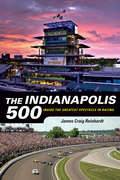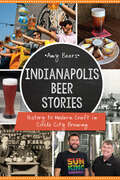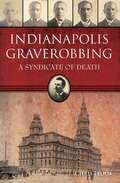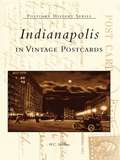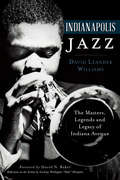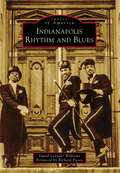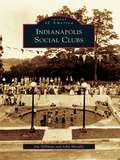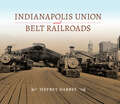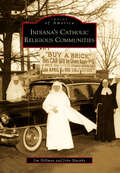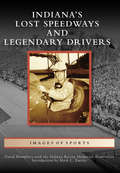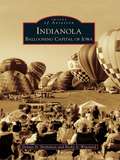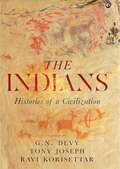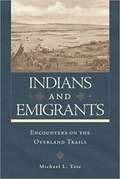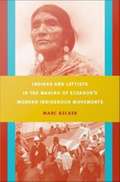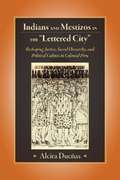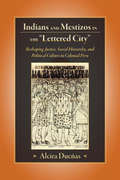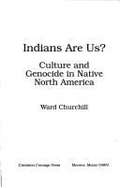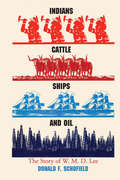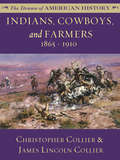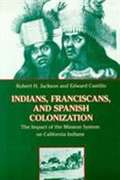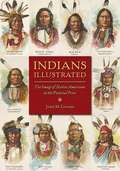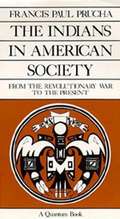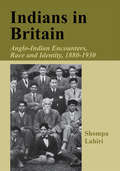- Table View
- List View
The Indianapolis 500: Inside the Greatest Spectacle in Racing
by James Craig ReinhardtKnown as the "Greatest Spectacle in Racing," the Indy 500 humbly began in 1911. Labeled as the first speedway, this two-and-a-half-mile oval is now home to many of today's top races, including the Brickyard 400, the Verizon IndyCar Series, the Monster Energy NASCAR Cup Series, the SportsCar Vintage Racing Association, the Red Bull Air Race World Championship, and its most famous race, the Indianapolis 500. In The Indianapolis 500: Inside the Greatest Spectacle in Racing, speedway tour guide and racing aficionado James Craig Reinhardt shares what makes the legendary racetrack special. He reveals the speedway's unbelievable history, fast-flying action, notorious moments, and its secrets, including facts about the beginning of the brickyard, why the drivers kiss the finish line, how milk became the drink of choice, and much more. The perfect gift for the veteran or rookie, The Indianapolis 500 is a must-have for all race fans.
Indianapolis Beer Stories: History to Modern Craft in Circle City Brewing (American Palate)
by Amy BeersIndianapolis Beer Stories is a time capsule of tales from the city's early taverns, to a pre-Prohibition golden era, to today's modern craft beer scene.Meet the ghosts of Indy's brewing past. Discover the very beginning of beer in Indiana's new capital and the pioneers who carved a path for a future industry. Uncover the legacy of a bygone brewing giant. Learn how one spontaneous decision to cross the treacherous Rocky Mountains led to a booming craft beer scene in Indiana.Indiana native Amy Beers, a Certified Cicerone® and owner/operator of Drinking with Beers, leads a heady tour of yesterday and today in Circle City brewing.
Indianapolis Graverobbing: A Syndicate of Death (True Crime)
by Chris FlookSurveying the sensational newspaper accounts as events unfolded, author and historian Chris Flook recounts this grisly tale of political intrigue and conspiracy. In the fall of 1902, Indianapolis police uncovered a prolific graverobbing ring operating across the city. At the time, cemeteries across central Indiana were relieved of their dead by ghouls, as they were called, seeking fresh corpses desperately needed by the city's medical colleges. The ring was also accused of multiple murders. In Hamilton County, a former Confederate soldier named Wade West delivered stolen corpses by floating them down the White River. His counterpart in Indianapolis, Rufus Cantrell, an itinerant preacher and full-time graverobber known as the "King of the Ghouls," ransacked Indy's cemeteries for years before being caught.
Indianapolis in Vintage Postcards (Postcard History)
by W. C. MaddenIn the late 1800s, postcards of Indianapolis began appearing in mailboxes throughout the country. Since that time, the many prominent monuments, buildings, and parks of the Hoosier capital have been featured on countless cards.Using an impressive collection of these images, author W.C. Madden takes the reader on an historic journey through Indianapolis from 1890 to 1950, providing a visual history of the development of the city. Indianapolis experienced great growth during the first half of the 20th century, which gave rise to innovative art and architectural structures, many that serve as the subject of postcards featured here. The Soldiers and Sailors Monument, the Indiana World War Memorial, the Indianapolis Motor Speedway, Union Station, and Claypool Hotel, to name a few, are all highlighted.
Indianapolis Jazz: The Masters, Legends and Legacy of Indiana Avenue (Music Ser.)
by David N. Baker David Leander WilliamsGet into the music with David Leander Williams as he charts the rise and fall of Indiana Avenue, the Majestic Entertainment Boulevard of Indianapolis, which produced some of the nation's most influential jazz artists. The performance venues that once lined the vibrant thoroughfare were an important stop on the Chitlin' Circuit and provided platforms for greats like Freddie Hubbard and Jimmy Coe. Through this biography of the bustling street, meet scores of the other musicians who came to prominence in the avenue's heyday, including trombonist J.J. Johnson and guitarist Wes Montgomery, as well as songwriters like Noble Sissle and Leroy Carr.
Indianapolis Rhythm and Blues (Images of America)
by David Leander WilliamsIndiana Avenue was traditionally the host to some of America's premier, world-renown entertainment icons in various genres. Along this winding, brightly lit thoroughfare were nightclubs, lounges, supper clubs, taverns, juke joints, and holes-in-the-wall that celebrated the best of the best in entertainment that America had to offer, from the 1920s on into the 1970s. On the bandstand at Denver Ferguson's Sunset Terrace Ballroom, the elegantly attired crooner Nat King Cole, in a sparkling blue silk suit, delivered his signature song "Mona Lisa." Nearby, B.B. King sang his 1973 down-home blues classic "To Know You is to Love You." At Tuffy Mitchell's Pink Poodle nightclub, "Moms" Mabley made the audience roar with laughter during her sidesplitting comedy routine. Indiana Avenue truly was the place to be for the best in entertainment.
Indianapolis Social Clubs (Images of America)
by John Murphy Jim HillmanMore than banquet halls, golf courses, and swimming pools, social clubs were a haven for businessmen, politicians, and community leaders, offering respite from public scrutiny. Defining Indianapolis, the clubs were stoic agents of power and segregation, providing clear historical snapshots of Hoosier pomp and circumstance. The clubs did more than produce Olympic swimmers, world-class golfers, and tennis professionals; they were Indianapolis's multigenerational playgrounds. There were the politics and business dealings at the Columbia Club and the Indianapolis Athletic Club, the golfing, tennis, and formality of Woodstock, Meridian Hills, and other country clubs, and the family fun in the sun at Riviera, Devon, and Olympia. These organizations offered more than magical summers with family and friends; they were the places to be seen.
Indianapolis Union and Belt Railroads (Railroads Past and Present)
by Jeffrey DarbeeIn an era dominated by huge railroad corporations, Indianapolis Union and Belt Railroads reveals the important role two small railroad companies had on development and progress in the Hoosier State. After Indianapolis was founded in 1821, early settlers struggled to move people and goods to and from the city, with no water transport nearby and inadequate road systems around the state. But in 1847, the Madison & Indianapolis Railroad connected the new capital city to the Ohio River and kicked off a railroad and transportation boom. Over the next seven decades, the Indiana railroad map expanded in all directions, and Indianapolis became a rail transport hub, dubbing itself the "Railroad City." Though the Pennsylvania and the New York Central Railroads traditionally dominated the Midwest and Northeast and operated the majority of rail routes radiating from Indianapolis, these companies could not have succeeded without the two small railroads that connected them. In the downtown area, the Indianapolis Union Railway was less than 2 miles long, and out at the edge of town the Belt Railroad was only a little over 14 miles. Though small in size, the Union and the Belt had an outsized impact, both on the city’s rail network and on the city itself. It played an important role both in maximizing the efficiency and value of the city’s railroad freight and passenger services and in helping to shape the urban form of Indianapolis in ways that remain visible today.
Indiana's Catholic Religious Communities
by Jim Hillman John MurphyWith expanding Irish, Swiss, French, and German immigrant populations, the state of Indiana evolved from individual explorers, trappers, hunters, and traders into family-focused communities of farmers and craftsmen. Emerging from the former Indiana Territory, the state's early population was in need of education, health care, and social services to assist young families, the poor, the infirm, and the elderly. These needs were frequently met by Catholic religious orders, including the Benedictines, Sisters of Providence, Franciscans, Daughters of Charity, and other established organizations of dedicated religious men and women.
Indiana's Lost Speedways and Legendary Drivers (Images of Sports)
by David HumphreyFrom the Indianapolis 500 Motor Speedway to the dirt oval tracks in small Indiana towns, thousands of Hoosiers frequent the raceway of their choice each year. Today, there are an estimated 40 asphalt, clay, and dirt-covered oval tracks in Indiana where race fans cheer local drivers, often navigating jalopies pieced together from junkyard parts, to victory lane. Though many racetracks remain in operation throughout the state, dozens have fallen to the wayside over the past 100 years. Forever in remembrance are the famous and not so famous Indiana-born drivers who thrilled fans at those now defunct tracks. Evansville native Charlie Wiggins won the Gold and Glory Sweepstakes four times. Bob Kinser from Bloomington raced over 40 years and is an inductee of the National Sprint Car Hall of Fame, and Tom Cherry of Muncie won the Little 500 four times.
Indianola: Ballooning Capital of Iowa (Images of Aviation)
by Dennis D. Nicholson Becky S. WigelandIndianola, founded in 1849, is the county seat of Warren County, Iowa. It is located 12 miles south of Iowa's capital, Des Moines, at the intersection of U.S. highways 65 and 69 and state highway 92. The city is home of the National Balloon Museum, begun in 1972; the National Balloon Classic, an annual nine-day balloon rally; the Balloon Federation of America's national office; Simpson College; the Des Moines Metro Opera, a widely acclaimed summer opera festival; and is host to the Iowa Wine Festival each summer. This book focuses on the history of ballooning in Indianola, which hosted the U.S. National Hot Air Balloon Championships from 1970 to 1988, and the National Balloon Classic from 1989 to the present. This is the story of how Indianola became the ballooning capital of Iowa.
The Indians: Histories of a Civilization
by G N Devy Ravi Korisettar Tony JosephThe Indians is one of the most ambitious projects yet undertaken to map the origins, evolution, and present-day reality of India's civilization and people. Written by over one hundred of South Asia's foremost scholars and domain experts, the essays in the book cover a period of some 12,000 years-from the last Ice Age to the twenty-first century. <p><p>The book is divided into seven sections. The first part looks at the evolution of humans in South Asia through the lens of the early 'Indian' population, their migrations, and the climate. The second part focuses on the emergence of different civilizations in the region through the domestication of plants and animals and other factors and how these civilizations eventually begin to decline. The third part discusses the languages and philosophies that defined ancient India-Buddhism, Jainism, Sanskrit, Indo-Iranian languages, and Pali literature, among others. The fourth part is a detailed study of society and culture in various geographical regions--the North, South, Northeast, the Deccan, East, and West India. The fifth part looks at the advent of colonialism and its impact on the country's economy, social fabric, and knowledge systems. The sixth part looks at Adivasi movements, Ambedkarite politics, Gandhian resistance, and other events that would come to form the bedrock of the independent republic. And, finally, the seventh part looks at contemporary India--the workings of the Constitution and urbanism, liberalization, and other aspects of the modern Indian experience. <p><p>Taken together, the essays in the book provide remarkable insights into Indian history and society.
Indians and Emigrants: Encounters on the Overland Trails
by Michael L. TateIn the first book to focus on relations between Indians and emigrants on the overland trails, Michael L. Tate shows that such encounters were far more often characterized by cooperation than by conflict. Having combed hundreds of unpublished sources and Indian oral traditions, Tate finds Indians and Anglo-Americans continuously trading goods and news with each other, and Indians providing various forms of assistance to overlanders. <P><P> Tate admits that both sides normally followed their own best interests and ethical standards, which sometimes created distrust. But many acts of kindness by emigrants and by Indians can be attributed to simple human compassion. <P><P> Not until the mid-1850s did Plains tribes begin to see their independence and cultural traditions threatened by the flood of white travelers. As buffalo herds dwindled and more Indians died from diseases brought by emigrants, violent clashes between wagon trains and Indians became more frequent, and the first Anglo-Indian wars erupted on the plains. Yet, even in the 1860s, Tate finds, friendly encounters were still the rule. <P><P> Despite thousands of mutually beneficial exchanges between whites and Indians between 1840 and 1870, the image of Plains Indians as the overland pioneers’ worst enemies prevailed in American popular culture. In explaining the persistence of that stereotype, Tate seeks to dispel one of the West’s oldest cultural misunderstandings.
Indians and Leftists in the Making of Ecuador's Modern Indigenous Movements
by Marc BeckerIn June 1990, Indigenous peoples shocked Ecuadorian elites with a powerful uprising that paralyzed the country for a week. Militants insisted that the government address Indigenous demands for land ownership, education, and economic development. This uprising was a milestone in the history of Ecuador's social justice movements, and it inspired popular organizing efforts across Latin America. While the insurrection seemed to come out of nowhere, Marc Becker demonstrates that it emerged out of years of organizing and developing strategies to advance Indigenous rights. In this richly documented account, he chronicles a long history of Indigenous political activism in Ecuador, from the creation of the first local agricultural syndicates in the 1920s through the galvanizing protests of 1990. In so doing, he reveals the central role of women in Indigenous movements and the history of productive collaborations between rural Indigenous activists and urban leftist intellectuals. Becker explains how rural laborers and urban activists worked together in Ecuador, merging ethnic and class-based struggles for social justice. Socialists were often the first to defend Indigenous languages, cultures, and social organizations. They introduced rural activists to new tactics, including demonstrations and strikes. Drawing on leftist influences, Indigenous peoples became adept at reacting to immediate, local forms of exploitation while at the same time addressing broader underlying structural inequities. Through an examination of strike activity in the 1930s, the establishment of a national-level Ecuadorian Federation of Indians in 1944, and agitation for agrarian reform in the 1960s, Becker shows that the history of Indigenous mobilizations in Ecuador is longer and deeper than many contemporary observers have recognized.
Indians and Mestizos in the "Lettered City"
by Alcira DuenasThrough newly unearthed texts virtually unknown in Andean studies, Indians and Mestizos in the "Lettered City" highlights the Andean intellectual tradition of writing in their long-term struggle for social empowerment and questions the previous understanding of the "lettered city" as a privileged space populated solely by colonial elites. Rarely acknowledged in studies of resistance to colonial rule, these writings challenged colonial hierarchies and ethnic discrimination in attempts to redefine the Andean role in colonial society. Scholars have long assumed that Spanish rule remained largely undisputed in Peru between the 1570s and 1780s, but educated elite Indians and mestizos challenged the legitimacy of Spanish rule, criticized colonial injustice and exclusion, and articulated the ideas that would later be embraced in the Great Rebellion in 1781. Their movement extended across the Atlantic as the scholars visited the seat of the Spanish empire to negotiate with the king and his advisors for social reform, lobbied diverse networks of supporters in Madrid and Peru, and struggled for admission to religious orders, schools and universities, and positions in ecclesiastic and civil administration. Indians and Mestizos in the "Lettered City" explores how scholars contributed to social change and transformation of colonial culture through legal, cultural, and political activism, and how, ultimately, their significant colonial critiques and campaigns redefined colonial public life and discourse. It will be of interest to scholars and students of colonial history, colonial literature, Hispanic studies, and Latin American studies.
Indians and Mestizos in the "Lettered City": Reshaping Justice, Social Hierarchy, and Political Culture in Colonial Peru
by Alcira Duenas Alcira DueñasThrough newly unearthed texts virtually unknown in Andean studies, Indians and Mestizos in the "Lettered City" highlights the Andean intellectual tradition of writing in their long-term struggle for social empowerment and questions the previous understanding of the "lettered city" as a privileged space populated solely by colonial elites. Rarely acknowledged in studies of resistance to colonial rule, these writings challenged colonial hierarchies and ethnic discrimination in attempts to redefine the Andean role in colonial society. Scholars have long assumed that Spanish rule remained largely undisputed in Peru between the 1570s and 1780s, but educated elite Indians and mestizos challenged the legitimacy of Spanish rule, criticized colonial injustice and exclusion, and articulated the ideas that would later be embraced in the Great Rebellion in 1781. Their movement extended across the Atlantic as the scholars visited the seat of the Spanish empire to negotiate with the king and his advisors for social reform, lobbied diverse networks of supporters in Madrid and Peru, and struggled for admission to religious orders, schools and universities, and positions in ecclesiastic and civil administration. Indians and Mestizos in the "Lettered City" explores how scholars contributed to social change and transformation of colonial culture through legal, cultural, and political activism, and how, ultimately, their significant colonial critiques and campaigns redefined colonial public life and discourse. It will be of interest to scholars and students of colonial history, colonial literature, Hispanic studies, and Latin American studies.
Indians Are Us?: Culture and Genocide in Native North America
by Ward ChurchillChurchill sets out to expose those who would appropriate native culture and turn it into a commodity to be bought and sold. He reviews books and movies which have historical inaccuracies and which perpetuate stereotypes. Other essays deal with the issue of products and sports teams and the impact of government definitions of who is and is not Indian.
Indians, Cattle, Ships, and Oil: The Story of W. M. D. Lee
by Donald F. SchofieldIndian trader, rancher, harbor developer, oil impresario—these are the many worlds of one of the least chronicled but most fascinating characters of the American West. In the early, bustling years of the frontier, a brazen young man named William McDole Lee moved from Wisconsin to Kansas and then to Texas to forge a life for himself. Becoming a driving entrepreneurial force in Texas's development, Lee soon garnered the alliances and resources necessary to shape the financial destinies of disparate groups throughout the state. His story is expertly told in Donald F. Schofield's Indians, Cattle, Ships, and Oil. Beginning in 1869 as a trader to the southern Cheyenne and Arapaho tribes and fort provisioner to troops garrisoned at Camp Supply, Indian Territory, Lee gained a partner and amassed a fortune in short order from trading buffalo hides and robes. Vast herds of buffalo grazing on the southern plains were killed largely on his order. When buffalo were no longer a profitable commodity, Lee tackled his next challenge—the cattle trade. He began with herds branded LR that grazed on pastures near Fort Supply. Then came his LE herd in the Texas Panhandle. Another partnership, with noted cattle rancher Lucien Scott, resulted in the vast LS ranch, one of the most successful operations of its day. Lee even introduced a new breed of cattle, the Aberdeen-Angus, to the western range. But as his partnership faded, Lee moved on to his next undertaking—the development of Texas' first deep-water harbor. In 1888, Lee and other financiers put up one million dollars to finance a dream: opening international trade from the waters of the Gulf of Mexico to the mainland at the mouth of the Brazos River. Their Brazos River Channel and Dock Company was to construct, own, and operate a deep-water harbor at Velasco, with a railroad link to Houston. Though threats of financial disaster loomed large, the Velasco facility was to welcome, in its day, tugs, barges, and three-masted schooners and to provide impetus for Houston's boom. Yet with success, the mercurial Lee turned to yet another challenge—oil. Starting still another partnership, Lee committed himself to prospecting for oil on the West Columbia Ridge in Brazoria County. Lee and crew struck oil in 1907, developing one of the first producing wells of Brazoria County, but inadequate drilling equipment hampered further fruitful exploration. Lee moved his rigs to the famed Spindletop, where he perfected the technique of shallow drilling. Though spectacular success in the oil business eluded him, Lee's accomplishments set him squarely among the great entrepreneurs of the Texas oil industry. Lee's exploits led him to roles in some of the most dramatic moments in Texas and the West—Indian uprisings, buffalo hunts, political scandals, cowboy strikes and shoot-outs, railroad promotions, oil-well blow-outs and gushers. The people he encountered are the famous and infamous of western history: Cheyenne Chief Little Robe and the outlaw "Hurricane Bill" Martin; Indian Agent John D. Miles and Major General John Pope; outlaws Tom Harris and William Bonney, and Sheriff Pat Garrett. Altogether, Lee's biography vividly shows one man's manipulation of people and events during the settlement of the American frontier.
Indians, Cattle, Ships, and Oil: The Story of W. M. D. Lee
by Donald F. SchofieldIndian trader, rancher, harbor developer, oil impresario—these are the many worlds of one of the least chronicled but most fascinating characters of the American West. In the early, bustling years of the frontier, a brazen young man named William McDole Lee moved from Wisconsin to Kansas and then to Texas to forge a life for himself. Becoming a driving entrepreneurial force in Texas's development, Lee soon garnered the alliances and resources necessary to shape the financial destinies of disparate groups throughout the state. His story is expertly told in Donald F. Schofield's Indians, Cattle, Ships, and Oil. Beginning in 1869 as a trader to the southern Cheyenne and Arapaho tribes and fort provisioner to troops garrisoned at Camp Supply, Indian Territory, Lee gained a partner and amassed a fortune in short order from trading buffalo hides and robes. Vast herds of buffalo grazing on the southern plains were killed largely on his order. When buffalo were no longer a profitable commodity, Lee tackled his next challenge—the cattle trade. He began with herds branded LR that grazed on pastures near Fort Supply. Then came his LE herd in the Texas Panhandle. Another partnership, with noted cattle rancher Lucien Scott, resulted in the vast LS ranch, one of the most successful operations of its day. Lee even introduced a new breed of cattle, the Aberdeen-Angus, to the western range. But as his partnership faded, Lee moved on to his next undertaking—the development of Texas' first deep-water harbor. In 1888, Lee and other financiers put up one million dollars to finance a dream: opening international trade from the waters of the Gulf of Mexico to the mainland at the mouth of the Brazos River. Their Brazos River Channel and Dock Company was to construct, own, and operate a deep-water harbor at Velasco, with a railroad link to Houston. Though threats of financial disaster loomed large, the Velasco facility was to welcome, in its day, tugs, barges, and three-masted schooners and to provide impetus for Houston's boom. Yet with success, the mercurial Lee turned to yet another challenge—oil. Starting still another partnership, Lee committed himself to prospecting for oil on the West Columbia Ridge in Brazoria County. Lee and crew struck oil in 1907, developing one of the first producing wells of Brazoria County, but inadequate drilling equipment hampered further fruitful exploration. Lee moved his rigs to the famed Spindletop, where he perfected the technique of shallow drilling. Though spectacular success in the oil business eluded him, Lee's accomplishments set him squarely among the great entrepreneurs of the Texas oil industry. Lee's exploits led him to roles in some of the most dramatic moments in Texas and the West—Indian uprisings, buffalo hunts, political scandals, cowboy strikes and shoot-outs, railroad promotions, oil-well blow-outs and gushers. The people he encountered are the famous and infamous of western history: Cheyenne Chief Little Robe and the outlaw "Hurricane Bill" Martin; Indian Agent John D. Miles and Major General John Pope; outlaws Tom Harris and William Bonney, and Sheriff Pat Garrett. Altogether, Lee's biography vividly shows one man's manipulation of people and events during the settlement of the American frontier.
Indians, Cowboys, and Farmers: 1865 - 1910
by James Lincoln Collier Christopher CollierHistory is dramatic -- and the renowned, award-winning authors Christopher Collier and James Lincoln Collier demonstrate this in a compelling series aimed at young readers. Covering American history from the founding of Jamestown through present day, these volumes explore far beyond the dates and events of a historical chronicle to present a moving illumination of the ideas, opinions, attitudes and tribulations that led to the birth of this great nation. Indians, Cowboys, and Farmers discusses the settling of the area between the Missouri River and the Rocky Mountains and the conflicting interests of the different groups involved--the Indians, cowboys, farmers, sheepherders, and railroad barons. The authors discuss the effect of the American policy of westward expansion on the Indian population, the rise and fall of the "Cattle Kingdom," and the importance of cross-country transportation. The text is enhanced with maps, photographs, and images of historic art & artifacts.
Indians, Franciscans, and Spanish Colonization: The Impact Of The Mission System On California Indians
by Robert Jackson Edward CastilloThis ethnohistory, now in paperback, examines Indian life in the twenty-one missions Franciscans established in Alta California. In describing how the missions functioned between 1769 and 1848, the authors draw on previously unused sources to analyze change and continuity in Indian material culture and religious practices. The twin goals of Franciscans were to mold Indians into a work force that would produce surplus grain for military garrisons and to regulate their moral conduct and religious practices. The authors use production records to show the missions were quite effective in serving the economic goals. Also carefully assessed are the efforts to transform the culture and world view of Indians by delineating how they coped, their history of disease and death, and their efforts at resistance.
Indians Illustrated: The Image of Native Americans in the Pictorial Press
by John M CowardAfter 1850, Americans swarmed to take in a raft of new illustrated journals and papers. Engravings and drawings of "buckskinned braves" and "Indian princesses" proved an immensely popular attraction for consumers of publications like Frank Leslie's Illustrated Newspaper and Harper's Weekly . In Indians Illustrated , John M. Coward charts a social and cultural history of Native American illustrations--romantic, violent, racist, peaceful, and otherwise--in the heyday of the American pictorial press. These woodblock engravings and ink drawings placed Native Americans into categories that drew from venerable "good" Indian and "bad" Indian stereotypes already threaded through the culture. Coward's examples show how the genre cemented white ideas about how Indians should look and behave--ideas that diminished Native Americans' cultural values and political influence. His powerful analysis of themes and visual tropes unlocks the racial codes and visual cues that whites used to represent--and marginalize--native cultures already engaged in a twilight struggle against inexorable westward expansion.
The Indians in American Society: From the Revolutionary War to the Present
by Francis P. PruchaAmerican Indian affairs are much in the public mind today- hotly contested debates over such issues as Indian fishing rights, land claims, and reservation gambling hold our attention. While the unique legal status of American Indians rests on the historical treaty relationship between Indian tribes and the federal government, until now there has been no comprehensive history of these treaties and their role in American life. Francis Paul Prucha, a leading authority on the history of American Indian affairs, argues that the treaties were a political anomaly from the very beginning. The term "treaty" implies a contract between sovereign independent nations, yet Indians were always in a position of inequality and dependence as negotiators, a fact that complicates their current attempts to regain their rights and tribal sovereignty. Prucha's impeccably researched book, based on a close analysis of every treaty, makes possible a thorough understanding of a legal dilemma whose legacy is so palpably felt today.
Indians in Britain: Anglo-Indian Encounters, Race and Identity, 1880-1930
by Shompa LahiriThis is an analysis of the nature and impact of the Indian presence in Britain, and British reactions to it. Problems of discrimination, isolation, and deprivation turned many students to politics, they appropriated ideas and institutions, and challenged British metropolitan society.
Indians in Kenya
by Sana AiyarSana Aiyar chronicles the strategies by which Indians sought a political voice in Kenya, from the beginning of colonial rule to independence. She examines how the strands of Indians' diasporic identity influenced Kenya's leadership--from partnering with Europeans to colonize East Africa, to collaborating with Africans to battle racial inequality.
